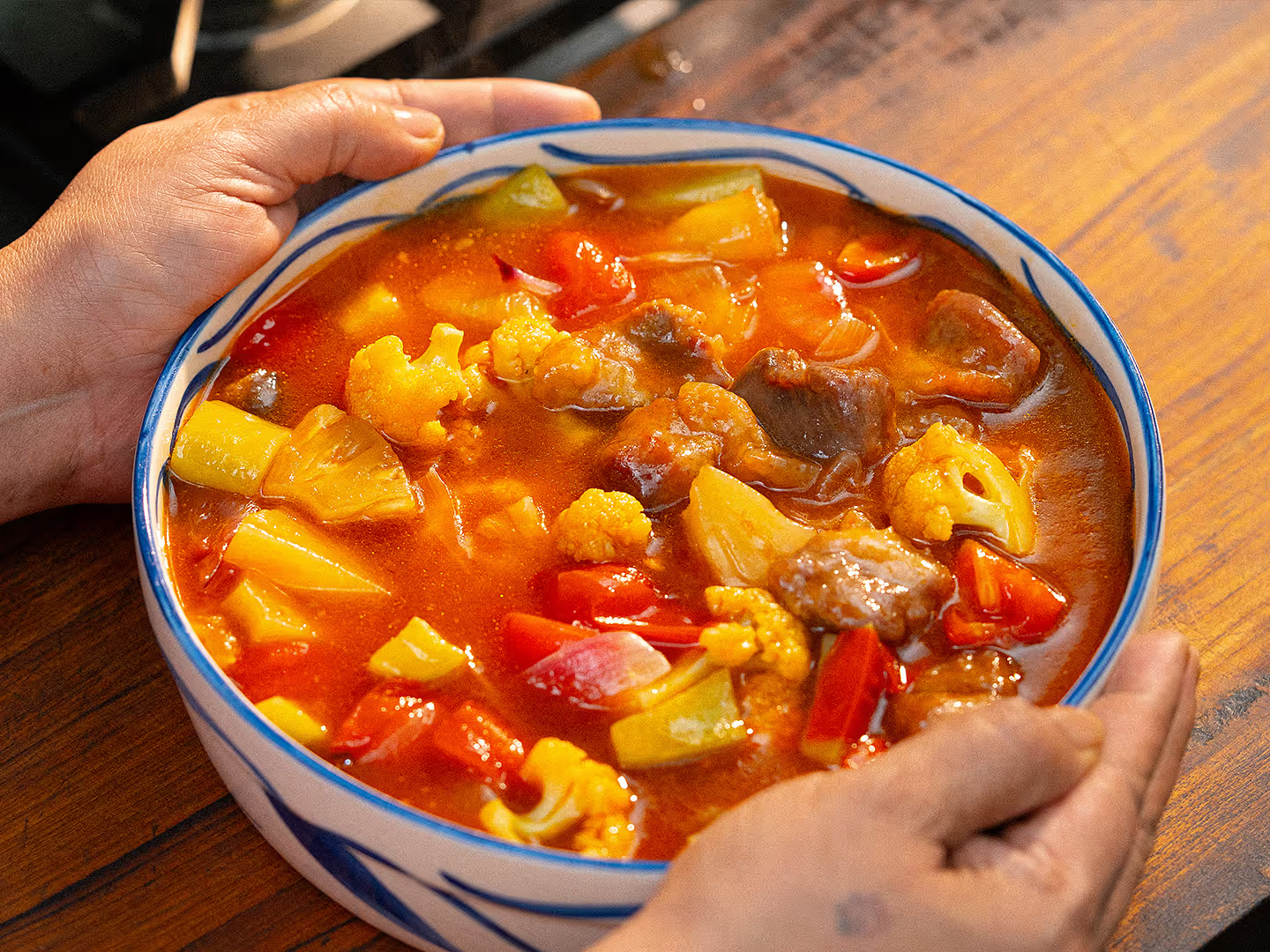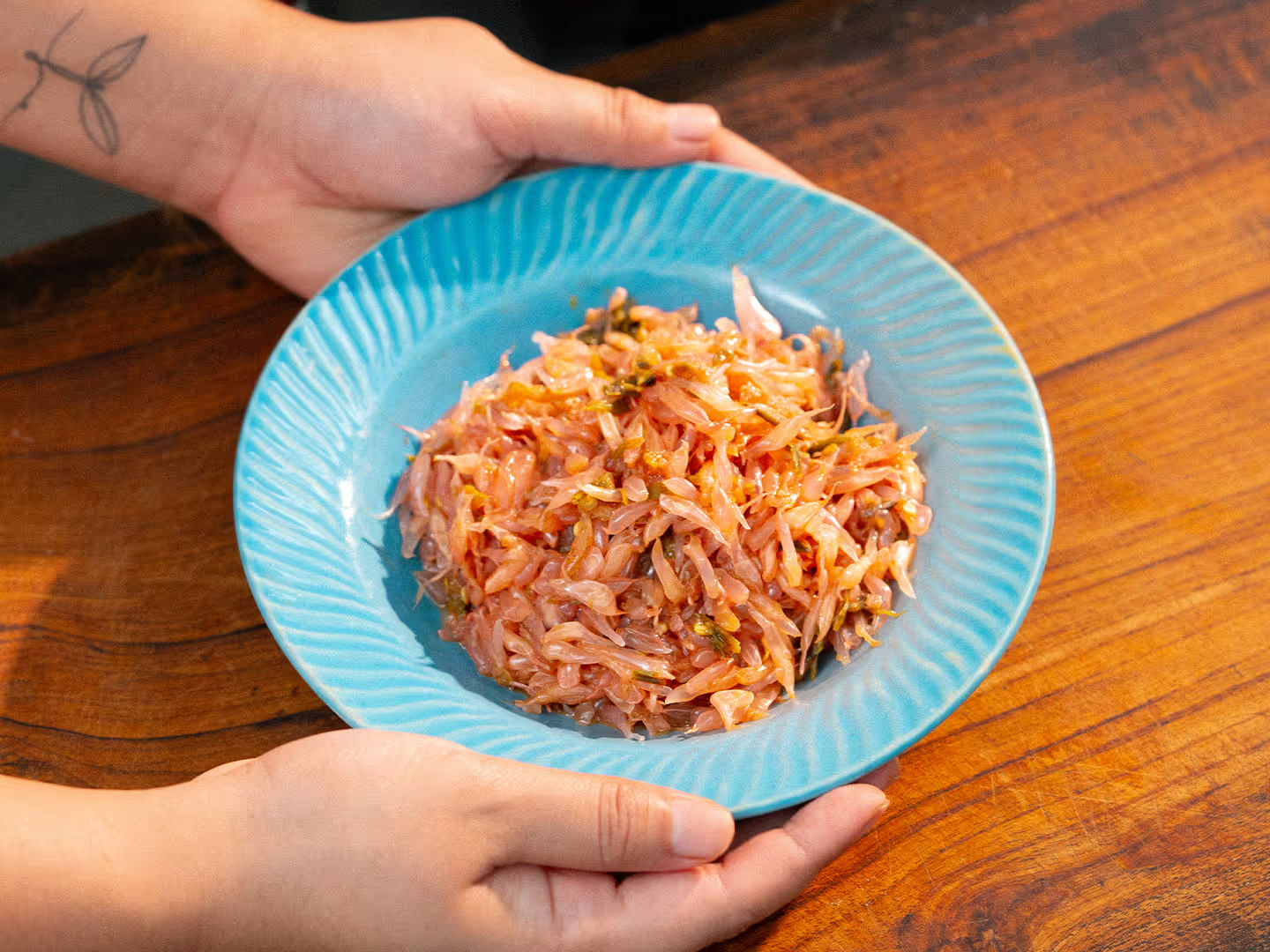Calcutta Chicken Rezala
Chicken cooked in a thin, pearly white gravy such as the kind served in restaurants like Sabir, Aminia, Shiraz, Royal, Arsalan, etc.
- Cooking time90 mins
- Calories371kcal
This is not a homestyle Calcutta rezala recipe. This is a no-holds-barred recipe—be it in the amount of oil or ghee, or the number of steps required. Our only goal was to make it as close to the restaurant-style rezala as possible. We have been looking for a reliable rezala recipe for a long time.
All the recipes we tried from the internet or books produced a rezala that tasted delicious, no doubt, but they were not close to the rezala that is served in Mughlai restaurants in Calcutta. That style of rezala is watery thin, yet rich, flavourful, pearl-white rezala with good centimetre of oil floating on the top—the kind served in Mughlai restaurants in Calcutta, such as Sabir, Aminia, Shiraz, Royal, Arsalan and the likes.
So, just like the kochuri alur torkari recipe from 2018, for those of you that remember, we went about reverse-engineering the rezala recipe. The first step was to taste rezalas from all of our favourites. We tasted them side by side. Then sometime last year we came across this video by Mr. Nadim Amin, one of the owners of Aminia—sadly he passed away a few years ago, but you should definitely check out his channel. His video acted as the starting point for us.
We cooked many, many batches, varying spices, cooking methods, using boiled onion vs raw, with and without poppy seeds, cashew, dry coconut—for several weeks all we were eating was rezala—until we arrived at this recipe which I think we are happy with. If you try it out, do tag us on Instagram.
***
FAQs
1. What kind of chicken should I use for rezala?
Small chicken under 800 grams for the whole bird, under 600 grams dressed without skin. The chicken has to be cut into quarters—two breasts with the wings and two legs with the thighs. Any chicken shop in Calcutta markets will know if you tell them it is for rezala.
2. Why are you parboiling the chicken?
You will see a lot of brown scum float to the top when you parboil the chicken. This is produced from the bone marrow, blood, the lungs, liver, etc. Parboiling the chicken and straining the stock keeps the rezala gravy white.
3. Can I reduce the quantity of oil?
You can cut the oil and ghee by up to half if you want, but the emulsified fats are what result in the silky nature of the gravy.
4. How can I simplify this recipe?
If you want, you can skip the parboiling step and add the raw chicken directly in after you get the base gravy ready. This will not reduce your total cooking time, since in this case you will need to cook the chicken longer, but it will reduce the number of utensils you need to wash. Another way to cook this in a hurry is to mix all of the ingredients together and cook over low heat until the chicken is fully cooked. Just keep the milk, kewra, and meetha attar mixture for the end, after you turn off the heat.
5. Your rezala looks watery. Can I make it creamier?
Rezala is not actually supposed to be very thick or creamy. I think of it as a white kaliya, not a korma, because it has a lot of water left behind even after the cooking is complete. Some restaurants such as Arsalan make it slightly thicker, while Shiraz and Sabir keep it completely watery. You can control this creaminess by increasing or decreasing the quantity of cashew, poppy and dry coconut mixture. If you want thin gravy like Sabir you can completely skip the cashew and just add poppy.
6. I have never seen dried coconut or khopra used in rezala. Is it required?
Some places add the dried coconut, some don’t, but we like the texture and flavour it adds. You should try it once at least.
7. Will it be sweet?
Rezala is usually sweet with one exception. Royal. If you like that style you can skip the sugar. Even if you add sugar the amount may vary based on what type of onion you use—some onions are sweeter than others—and how sour your yoghurt is—the more sour your yoghurt, the more sugar is needed to balance the sourness. In general try to use fresh curd that is not very sour.
8. I want to cook this for a party. How do I cook ahead of time?
The milk and aromatic mix has to be added after the heat is turned off. If you are making rezala for later and know that you will need to reheat it, then add the milk mixture after you reheat, just before serving.
9. Are there any specialty ingredients that I should be aware of?
Not really—we found everything we needed in local bajars such as New Market, Park Circus and Gariahat. You will need to buy small chicken (under 800g whole), divided in quarters. If you tell the shopkeeper you want chicken for rezala, they'll give you the right size. Khopra is dried coconut, which should be available with slightly large local grocers. The ghee we've used here is not the regular caramelised ghee we use for other recipes. It is white buffalo-milk ghee, Srighito (Sree Ghee), from a very old Bengali brand, which comes in its iconic red-and-gold tin. This is the ghee used in Mughlai restaurants in Kolkata. Meetha attar, or the essence used in Mughlai cooking in Bengal has a unique, heady aroma (which gives our biryani its distinctive smell). We bought our bottle of Deer Brand meetha attar from New Market.
Frequently Asked Questions
Books in this recipe
Ingredients
To boil the chicken
- 1 kg chicken (see note above on type and cut)
- 30 g onion
- 10 g sliced ginger
- 4 cardamom
- 4 cloves
- 2 cinnamon
- 4 bay leaves
- 20 peppercorns
- 14 g salt
- 600 ml water
Mise en place
- 3 g coriander powder (sifted)
- 1 g mace (lightly toasted)
- 2 g white peppercorns (lightly toasted)
- 10 g poppy seeds (lightly toasted)
- 5 g cashewnuts (lightly toasted)
- 10 g khopra (dried coconut, peeled and lightly toasted)
- 5 g garlic
- 10 g ginger
- 100 g white onion
For cooking
- 45 g vegetable oil
- 80 g ghee
- 4 dried red chillies
- 10 makhana
- 2 cardamom
- 1 mace
- 10 black peppercorns
- ½ tsp cornflour
- 150 g yoghurt
- 3 g salt
- 12 g sugar
- 50 ml warm milk
- 10 g green chillies
- ¼ tsp kewra water
- ½ a drop meetha attar
- rose petals for garnish
Method
Boil the chicken
- Wash the chicken very well. Set it to boil with salt, water and spices listed here.
- After about 15 minutes, fetch the chicken out, and strain the stock. Set aside.
Mise en place
- Sift coriander powder.
- Separately, lightly toast mace and white peppercorns. Grind them to a fine powder.
- Separately, lightly toast poppy seeds, cashew, and khopra (peeled). Grind to a powder.
- Grind ginger and garlic with water. Strain over a fine tea-strainer to extract the juice.
- Grind white onion to a smooth paste.
Cooking rezala
- Heat vegetable oil and ghee in a pan on low heat.
- Fry red chillies for a minute and set aside. Fry makhana unil crisp and set aside.
- Temper the oil with mace, peppercorn and cardamom.
- Add onion paste and fry on low heat for 10 mins.
- Add the ginger-garlic juice and continue frying for 5 mins.
- Add sifted coriander, and the mace-peppercorn powder, and continue frying for 3 mins.
- Then add the poppy, cashew and khopra mixture and fry another 3 mins.
- Make a slurry of cornflour and add it to the yoghurt. Beat thoroughly until lump free. Add it to pan, and whisk constantly so that the yoghurt doesn't split.
- Once the yogurt has cooked down, and you see oil float to the top, add the par-boiled chicken, stock, salt and sugar. Boil on medium heat for 30 mins.
- To finish, grind green chillies with a tbsp of milk. Strain it back into the rest of the milk. Also mix in kewra water and meetha attar.
- Once the chicken is tender and gravy has thickened, turn off the heat. Add the milk, chillies and aromatics mixture.
- Add the fried red chillies and makhana we had set aside earlier. Garnish with rose petals.































